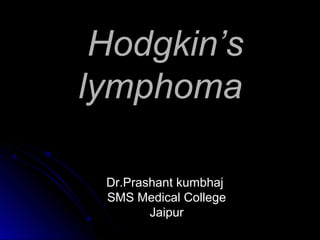
Hodgkin lymphoma
- 1. Hodgkin’s lymphoma Dr.Prashant kumbhaj SMS Medical College Jaipur
- 2. Lymphoma Clonalmalignant disorders that are derived from lymphoid cells: either precursor or mature T-cell or B-cell Majority are of B- cell origin Dividedinto 2 main types : 1. Hodgkin’s lymphoma 2. Non - Hodgkin’s lymphoma
- 3. Hodgkin’s Disease Histologically & clinically a distinct malignant disease Predominantly, B-cell disease Course of the disease is variable, but the prognosis has improved with modern treatment
- 4. Etiology Infection – EBV,HIV Higher social class,advanced education Environmental factors
- 5. WHO Classification Classic:(CD 15+,CD30+) Nodular Sclerosis-70%,Adolesent and young adults,mediastinal mass Lymhocyte rich-10% Mixed Cellularity-20%,young children, Lymhocyte depleted-<5%,mostly in AIDS,B symptoms ,worst prognosis Non-Classic NodularLymphocyte predominant Best OS,B Symptoms <10%
- 6. HISTOLOGY Diagnosis of HL depends on RS cells(reedsternberg cells ) Bulk of lymphatic tissue is not composed of malignent cells but rather a vareity of normal appearing lymphocytes ,plasma cells ,eosinophils ,neutrophils,histiocytes. Importent varient of reedsternberg cells includes L&H(lymphocyte and histiocyte)cells,lacunar cells,RS like cells.
- 7. Reed sternberg cells are giant cells with binucleate and large cytoplasmic eosinophilic inclusions CD 15+, CD30+
- 8. Clinical features Bimodal age distribution : young adults ( 20-30 yrs) & elderly (> 50yrs) May occur at any age M >F Lymphadenopathy: most often cervical region asymmetrical, discrete painless, non-tender elastic character on palpation ( rubbery) not adherent to skin fluctuate in size
- 9. MODE OF SPREAD HL always almost originate in a lymph node It spreads in orderly fashion through lymphatic system by contiguity Axial lymphatic system is always involved whereas distal sites (epitrochiliar ,popliteal) rarely involved. Hematogenous involvement occurs late and is common in LD type .
- 10. Contiguous spread via the lymphatic chain eg.involvement of abdominal & thoracic LNs Extra nodal disease - rare Hepatospleenomegaly
- 11. Sites of involvment Peripheral lymph node-Cervical or Supraclavicular lymphadenopathy occurs in >70% of cases .axillary and inguinal lymph nodes are less frequently involved . Generalized lymphadenopathy is atypical of HL Spleen ,splenic hilar nodes,and celiac nodes are the earliest abdominal sites of invovlement in infradiaphragmatic HL. Mesentric lymph nodes are rarely involved
- 12. Thorax Ant mediastinum is primary location for NS HL Lung involvement may occur by direct contiguity with hilar involvement as well as hematogenous invovlement . Plural effusion may occur by lymphatic compression SVC is more common in NHL
- 13. Abdominal Spleen ,splenic hilar nodes ,celiac nodes are the earliest sites of invovment in abdomen Mesentric lymph nodes are rarely involved. Liver involvement is uncommon at diagnosis and is always almost associated with infiltration of the spleen.
- 14. Retero peritoneal lymph node involvement occurs late in the course of supradiagphramatic HL and after spleen,splenic hilar nodes and celiac nodal involvement . Bone marrow- rarely involved at the time of diagnosis ,pt with advanced stage and systemic symptoms ,LD,MC are common types of bone marrow involvement .
- 15. Constitutional symptoms ( B symptoms ) Night sweats, sustained fever > 38 degree celsius, loss of weight >10% of body weight in 6 months Fever sometimes cyclical (‘Pel-Ebstein fever’) Pain at the site of disease after drinking alcohol Pallor Pruritis Symptoms of Bulky (>10 cm) disease
- 16. Extranodal Liverand skin involvement is rare CNS involvement uncommon No involvement of meninges ,brain ,waldeyars ring.
- 17. Investigations CBC : Anemia ( normochromic / normocytic), eosinophilia, neutrophilia, lymphopenia ESR -raised LFT- (liver infil / obs at porta hepatis) RFT- prior to treatment Urate , Ca, LDH - adverse prognosis CXR- mediastinal mass CT thorax / abdomen / pelvis-for staging Other: Gallium scan, PET, Lymphangiography , Laporotomy
- 18. LN FNAC / biopsy : Malignant REED-STERNBERG ( RS) Cell: Bi- nucleate cell with a prominent nucleolus. Derived from B cell, at an early stage of differentiation Reactive background of eosinophils, lymphocytes, plasma cells Fibrous tissue
- 19. REED-STERNBERG ( RS ) Cell
- 20. REED-STERNBERG ( RS) Cell
- 23. An Arbor Staging Stage I : Involvement of single LN region (I) or extra lymphatic site (IAE ) Stage II : Two or more LN regions involved (II) or an extra lymphatic site and lymph node regions on the same side of diaphragm Stage III : Involvement of lymph node regions on both sides of diaphragm, with (IIIE) or without (III) localized extra lymphatic involvement or involvement of the spleen (IIS) or both (IISE) Stage IV : Involvement outside LN areas (Liver, bone marrow) A : Absence of ‘B’ symptoms B : B symptoms present
- 25. Adverse prognostic factors Male sex Age >45yrs Stage IV Hemoglobin<10.5g/dl WBC count >15,000/ul Lymphocyte count <600/ul Serum albumin <4g/dl
- 26. Treatment RT Chemo BMT / SCT Supportive
- 27. Treatment - Guidelines Indicationsfor RT: Stage I disease Stage II disease with 3 or lesser areas involved For Bulky disease For pressure problems Indications for CT All with B symptoms Stage II disease with >3 areas involved Stage III and IV disease
- 28. Treatment Stage IA , Stage IIA with 3 or < 3 areas involved: ABVD X 4 CYCLES WITH IFRT(CLASSICAL HL) NLPHL – IFRT ALONE ,OBSERVATION(IF PT CANNOT TOLERATE RT) Stage IB, Stage II A with > 3 areas , Stage IIB: ChemotherapyABVD every 3-4 weeks, 6 cycles; either alone, or in combination with radiotherapy Stage III & IV : Chemotherapy + Radiotherapy ( for bulky
- 29. Irradiation fields used in Hodgkin’s Lymphoma
- 30. Chemotherapy MOPP : Nitrogen Mustard, Vincristine (Oncovin), Procarbazine, Prednisolone ABVD: Adriamycin, Bleomycin, Vinblastine, Dacarbazine Higher dose for relapse or younger pts with poor
- 31. Prognosis Overall 10 yr survival – 80% In long term survivors there is a risk of secondary malignancy: (leukemia , NHL), Solid ( tumors- Lung, breast Infections Cardiac, pulmonary, endocrinal abnormalities
- 32. Side effects of treatment HYPOTHYROIDISM STERLILITY LUNG DAMAGE BLEOMYCIN PULMONARY TOXICITY CARDIAC DAMAGE ASEPTIC NECROSISOF FEMORAL HEADS DEPRESSED CELLULAR IMMUNITY
- 33. SECONDARY NEOPLASM – AML,NHL,EPITHELIAL TUMORS ,SARCOMAS , NEUROLOGIC COMPLICATIONS RETROPERITONEAL FIBROSIS NEPHROTIC SYNDROME ICHTHYOSIS